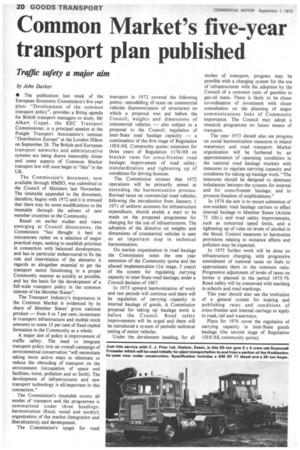Common Market's five-year transport plan published
Page 22

If you've noticed an error in this article please click here to report it so we can fix it.
Traffic safety a major aim
by John Darker
• The publication last week of the European Economic Commission's five year plan: "Development of the common transport policy", provides a fitting agenda for British transport managers to study. Mr Albert Coppe. the EEC Transport Commissioner, is a principal speaker at the Freight Transport Association's seminar "Distribution Europe" at the London Hilton on September 26. The British and European transport networks and administrative systems are being drawn inexorably closer and some aspects of Common Market transport law will soon begin to "bite" in the UK.
The Commission's document, now available through HMSO, was submitted to the Council of Ministers last November. The timetable appended to the document, therefore, begins with 1972 and it is stressed that there may be some modifications to the timetable through the advent of new member countries to the Community.
Based on earlier studies and views emerging at Council discussions, the Commission "has thought it best to concentrate rather on a selection of major practical steps, seeking to establish priorities in connection with balanced development, and has in particular endeavoured to fix the role and interrelation of the elements it regards as altogether essential to get the transport sector functioning in a proper Community manner as quickly as possible, and lay the basis for the development of a full-scale transport policy in the common interest of the Member States".
The Transport Industry's importance in the Common Market is evidenced by its share of Member States' gross national product — from 4 to 7 per cent; investment in transport infrastructure and mobile stock amounts to some 15 per cent of fixed capital formation in the Community as a whole.
A major aim of policy is improvement of traffic safety. The need to integrate transport policy into an overall campaign of environmental conservation "will necessitate taking more active steps to eliminate or reduce the obtruding of transport on the environment (occupation of space and facilities, noise, pollution and so forth). The development of infrastructures and new transport technology is all-important in this connection."
The Commission's timetable covers all modes of transport and the programme is summarized under three headings: harmonization (fiscal, social and sundry); organization of the market (integration and liberalization); and development.
The Commission's target for road transport in 1972 covered the following points: remodelling of taxes on commercial vehicles (harmonization of structures) on which a proposal was put before the Council; weights and dimensions of commercial vehicles — also subject to a proposal to the Council; regulation of inter-State road haulage capaCity — a continuation of the first stage of Regulation 1018/68, Community quota; extension for three years of Regulation 1174/68 on bracket rates for cross-frontier road haulage; improvement of road safety; standardization and tightening up of conditions for driving licences.
The Commission stresses that 1972 operations will be primarily aimed at extending the harmonization process. Revised taxes on commercial road vehicles, following the introduction from January 1 1971 of uniform accounts for infrastructure expenditure, should enable a start to be made on the proposed programme for charging for the use of infrastructures. The adoption of the directive on weights and dimensions of commercial vehicles is seen as an important step in technical harmonization.
On market organization in road haulage the Commission notes the one year extension of the Community quota and the phased implementation (1st stage, 3 years) of the system for regulating carrying capacity in inter-State road haulage, under a Council decision of 1967.
In 1973 upward harmonization of work and rest periods will continue and there will be regulation of carrying capacity in internal haulage of goods. A Commission proposal for taking up haulage work is before the Council. Road safety improvements will be urged and there will be introduced a system of periodic technical testing of motor vehicles.
Under the develoment heading, for all modes of transport, progress may be possible with a charging system for the use of infrastructures with the adoption by the Council of a common ratio of gasoline to gas-oil taxes. There is likely to be closer co-ordination of investment with closer consultation on the planning of major communications links of Community importance. The Council may adopt a research programme on future means of transport. .
The year 1973 should also see progress on social harmonization measures in inland waterways and road transport. Market organization will be furthered by an approximation of operating conditions in the national road haulage markets with measures to regulate carrying capacity and conditions for taking up haulage work. "The measures should be designed to eliminate imbalances between the systems for internal and for cross-frontier haulage. and to promote freedom of establishment."
In 1974 the aim is to secure admission of non-resident road haulage carriers to effect internal haulage in Member States (Article 75 1(b) ), and road safety improvements, such as concerted speed limits, and a tightening up of rules on levels of alcohol in the blood. Control measures to harmonize provisions relating to nuisance effects and pollution may be expected.
In 1975 further work will be done on infrastructure charging, with progressive amendment of national taxes on fuels to approximate them to the common ratio. Progressive adjustment of levels of taxes on lorries is planned in the period 1975-79. Road safety will be concerned with teaching in schools and road markings.
This year should also see the institution of a general system for making and publishing rates and conditions of cross-frontier and internal carriage to apply to road, rail and waterways.
Plans for 1976 cover the regulation of carrying capacity in inter-State goods haulage (the second stage of Regulation 1018/68, community quota).


































































































